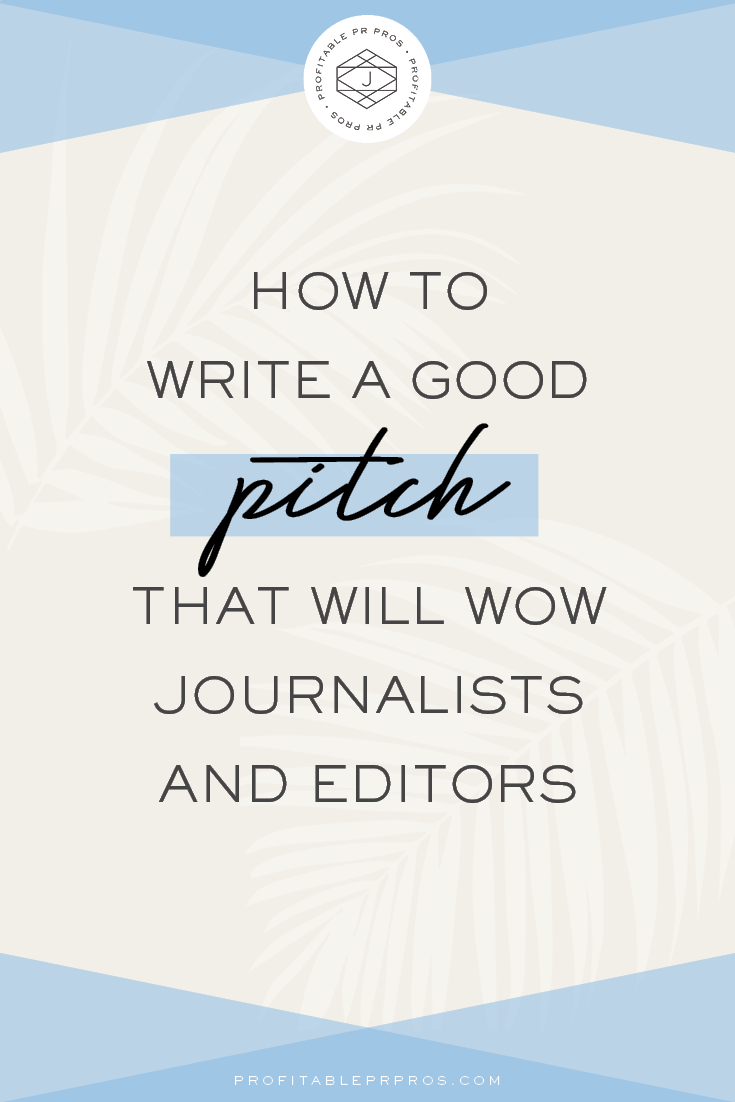How To Write A Good Pitch That Will Wow Journalists and Editors
Mar 28, 2022
Creating compelling, killer pitches is essential for every PR pro. If you want to land incredible features for your clients, you need to have stellar pitching skills—but you’ve also got to put in the work! Pitch writing is a skill, and it doesn’t always come naturally. If you’re wondering how to write a good pitch, there are some key strategies you need to know.
How to Write a Good Pitch and Wow Journalists and Editors
If you want to land an epic feature (and impress your clients with your results!), the most important thing you need is a winning pitch. Here are 7 of the BEST ways to enhance your media pitches so you can secure top-tier press placements for your clients.
Infuse Personality Into Your Pitches
There’s nothing worse than a cold, robotic, spray-and-pray pitch. You won’t land any pitches without bringing your personality into it! Connecting with an editor on a personal level is so important.
Remember that there’s an actual human being on the other side of this pitch. You want them to be excited about this pitch! Convey genuine enthusiasm in your writing and make them feel it.
That said, this is still a professional email. Bring personality to your pitches and talk to journalists how you’d talk to a friend—while keeping things respectful.
Highly Tailor Your Pitches
One of the most fundamental aspects of knowing how to write a good pitch is understanding that personalization is essential. Tailor your pitches to the outlet you’re pitching and the exact journalist receiving the pitch.
Make it clear that your pitch is for that specific person and that you’re pitching to them because you KNOW this story would be perfect for them. Pitch creative angles that align with the editor or journalist’s specialty and audience.
Customize your pitches as much as possible for each journalist, editor, and publication. When you do that, editors will know that you’re up-to-date on their work and trust you to pitch them relevant angles in that niche. The more specific and tailored your pitches are, the more likely you’ll land the perfect press feature.
Specifically Mention Affiliate Relationships
Many outlets only want to feature brands available on sites with affiliate programs. They may request pitches for products available on specific retail platforms, like Ulta or Sephora. Some publications also have other specifications they look for, like rating or review statistics.
Journalists and editors need to know if there’s a possibility for affiliate commission with your client’s product, as it could influence what makes it into their final piece. Make their jobs easier by including any affiliate relationships in your pitch, so they don’t have to track you down for this info later on.
Amazon is a widely-used platform for affiliate commission, and it’s the most common platform many outlets are looking for. If your client’s product is available on Amazon, mention it in your pitch! But be subtle, not sales-y: a simple “By the way, we’re available on Amazon!” is more than enough.
Inside The Pitch Lab, you can access an entire library of exclusive masterclasses, including one all about leveraging the power of affiliate marketing for your PR clients.
Write Compelling Subject Lines
Journalists and editors are flooded with hundreds of emails every single day. Your subject line can be the make-it-or-break-it factor that lets your email stand out and prompts the editor to open it. A great subject line makes a HUGE difference in the success of your pitch and gives you a chance to build credibility and value right off the bat.
Writing a killer subject line is easier said than done, though. Shorter is better, so you’re only working with ten words or less here—the subject line should ideally be between 41 and 64 characters total.
You should also use searchable keywords in your subject line to make the pitch easy to find in the journalist’s inbox. Include a statistic, newsworthy observation, or expert name in the subject line. All of this will help your pitch stand out in a crowded inbox!
Don’t overthink this and end up stuck in perfection paralysis. The goal of a subject line is just to get the email opened. Keep it simple, powerful, and searchable, then hit send!
Struggling with writing compelling headlines? Join The Pitch Lab and get access to our “Headline Hacks” resource with over 100 subject lines that actually work!
Be Short and Sweet
Being succinct is “How To Write A Good Pitch 101.” Winning pitches are engaging, timely, and concise.
Journalists and editors are busy people! If you can’t frame a media approach with an exciting storyline in less than 180 words, take a second. It might be time to pause, reflect on what you’re trying to convey, and rework the body of the pitch.
Don’t be afraid to take a break and come back to a pitch with fresh eyes.
Though you need to keep it short, there are a few pitching basics you need to keep in mind. The intro paragraph should be about 2-3 sentences and should highlight the primary purpose of the pitch. Lay the foundation with your intro sentence and make the journalist want to read more.
Then, move on to the body of the pitch. Include details to support that main idea you introduced in the first paragraph.
Avoid sending attachments with your pitches. Include those details in the body of the pitch instead, and hyperlink to your client’s site if necessary.
Review Your Pitches Before Sending Them
This step is critical! Don’t let a simple spelling or grammar mistake prevent you from landing a game-changing press placement.
Beyond that, readability is a significant part of a winning pitch.
There are a few simple strategies you can use to improve the readability of your pitch:
- Use bullet points to break up heavy text
- Bold words or sentences to make interesting nuggets stand out more
- Focus on scannable and skimmable text—journalists will appreciate being able to fully comprehend your pitch after a quick scan.
Keep things simple and compelling! Double-check the submission guidelines for each publication to make sure you’re adhering to their style guide before sending your pitch. Avoid using industry jargon or too much technical language.
Related: How to Improve Your Media Pitches to Get More PR Features
Include a Clear Call-To-Action
The last part of writing a good pitch is learning how to craft a targeted call-to-action (or CTA).
The CTA should be at the top or middle of the pitch. Avoid burying it in and making it difficult for the editor to find.
Your reader should understand the takeaway of your pitch just by skimming the text. Communicate the next steps they can take after reading your pitch to engage and move the process along.
A clear CTA can be setting up an interview with a client or offering an expert as a guest for a podcast. It could also be sharing a byline article for the editor’s consideration or requesting product samples.
Regardless of what your CTA is, it should also tell the journalist whether they should take action on the pitch now or save it for future reference.
Identifying and offering an expert source from the onset is a critical value-add in the journalist-PR pro dynamic. Plus, it’ll help you build solid and lasting relationships.
With these seven tips, knowing how to write a good pitch is simpler than ever. These strategies will help you craft more compelling, winning pitches to score epic features for your clients. 








